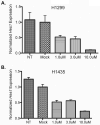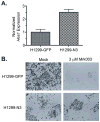Notch signaling contributes to lung cancer clonogenic capacity in vitro but may be circumvented in tumorigenesis in vivo
- PMID: 21994468
- PMCID: PMC3243765
- DOI: 10.1158/1541-7786.MCR-11-0286
Notch signaling contributes to lung cancer clonogenic capacity in vitro but may be circumvented in tumorigenesis in vivo
Abstract
The Notch signaling pathway is a critical embryonic developmental regulatory pathway that has been implicated in oncogenesis. In non-small cell lung cancer (NSCLC), recent evidence suggests that Notch signaling may contribute to maintenance of a cancer stem or progenitor cell compartment required for tumorigenesis. We explored whether intact Notch signaling is required for NSCLC clonogenic and tumorigenic potential in vitro and in vivo using a series of genetically modified model systems. In keeping with previous observations, we find that Notch3 in particular is upregulated in human lung cancer lines and that downregulation of Notch signaling using a selective γ-secretase inhibitor (MRK-003) is associated with decreased proliferation and clonogenic capacity in vitro. We show that this phenotype is rescued with the expression of NICD3, a constitutively active cleaved form of Notch3 not affected by γ-secretase inhibition. Using an inducible LSL-KRAS(G12D) model of lung cancer in vivo, we show a transient upregulation of Notch pathway activity in early tumor precursor lesions. However, a more rigorous test of the requirement for Notch signaling in lung oncogenesis, crossing the LSL-KRAS(G12D) mouse model with a transgenic with a similarly inducible global dominant-negative suppressor of Notch activity, LSL-DNMAML (dominant-negative mastermind-like), reveals no evidence of Notch pathway requirement for lung tumor initiation or growth in vivo. Distinct Notch family members may have different and potentially opposing activities in oncogenesis, and targeted inhibition of individual Notch family members may be a more effective anticancer strategy than global pathway suppression.
Figures






Similar articles
-
Gamma-secretase inhibitor prevents Notch3 activation and reduces proliferation in human lung cancers.Cancer Res. 2007 Sep 1;67(17):8051-7. doi: 10.1158/0008-5472.CAN-07-1022. Cancer Res. 2007. PMID: 17804716
-
Aldehyde dehydrogenase activity selects for lung adenocarcinoma stem cells dependent on notch signaling.Cancer Res. 2010 Dec 1;70(23):9937-48. doi: 10.1158/0008-5472.CAN-10-0881. Epub 2010 Nov 30. Cancer Res. 2010. PMID: 21118965 Free PMC article.
-
Prolonged inhibition of glioblastoma xenograft initiation and clonogenic growth following in vivo Notch blockade.Clin Cancer Res. 2013 Jun 15;19(12):3224-33. doi: 10.1158/1078-0432.CCR-12-2119. Epub 2013 Apr 29. Clin Cancer Res. 2013. PMID: 23630166 Free PMC article.
-
Rethinking Gamma-secretase Inhibitors for Treatment of Non-small-Cell Lung Cancer: Is Notch the Target?Clin Cancer Res. 2018 Dec 15;24(24):6136-6141. doi: 10.1158/1078-0432.CCR-18-1635. Epub 2018 Aug 13. Clin Cancer Res. 2018. PMID: 30104200 Free PMC article. Review.
-
Notch Signaling in Breast Cancer: A Role in Drug Resistance.Cells. 2020 Sep 29;9(10):2204. doi: 10.3390/cells9102204. Cells. 2020. PMID: 33003540 Free PMC article. Review.
Cited by
-
Inhibition of notch signaling in combination with Paclitaxel reduces platinum-resistant ovarian tumor growth.Front Oncol. 2014 Jul 7;4:171. doi: 10.3389/fonc.2014.00171. eCollection 2014. Front Oncol. 2014. PMID: 25072022 Free PMC article.
-
FLI-06 Intercepts Notch Signaling And Suppresses The Proliferation And Self-renewal Of Tongue Cancer Cells.Onco Targets Ther. 2019 Sep 18;12:7663-7674. doi: 10.2147/OTT.S221231. eCollection 2019. Onco Targets Ther. 2019. PMID: 31571917 Free PMC article.
-
Opposing role of Notch1 and Notch2 in a Kras(G12D)-driven murine non-small cell lung cancer model.Oncogene. 2015 Jan 29;34(5):578-88. doi: 10.1038/onc.2013.592. Epub 2014 Feb 10. Oncogene. 2015. PMID: 24509876
-
Identifying specific Notch1 target proteins in lung carcinoma cells.Histol Histopathol. 2021 Jan;36(1):69-76. doi: 10.14670/HH-18-271. Epub 2020 Oct 23. Histol Histopathol. 2021. PMID: 33094831
-
FHL1C induces apoptosis in Notch1-dependent T-ALL cells through an interaction with RBP-J.BMC Cancer. 2014 Jun 22;14:463. doi: 10.1186/1471-2407-14-463. BMC Cancer. 2014. PMID: 24952875 Free PMC article.
References
-
- Jemal A, Siegel R, Xu J, Ward E. Cancer statistics, 2010. CA Cancer J Clin. 2010;60:277–300. - PubMed
-
- Reya T, Morrison SJ, Clarke MF, Weissman IL. Stem cells, cancer, and cancer stem cells. Nature. 2001;414:105–11. - PubMed
-
- Clevers H. The cancer stem cell: premises, promises and challenges. Nat Med. 2011;17:313–9. - PubMed
-
- Bonnet D, Dick JE. Human acute myeloid leukemia is organized as a hierarchy that originates from a primitive hematopoietic cell. Nat Med. 1997;3:730–7. - PubMed
Publication types
MeSH terms
Substances
Grants and funding
LinkOut - more resources
Full Text Sources
Molecular Biology Databases
Miscellaneous

